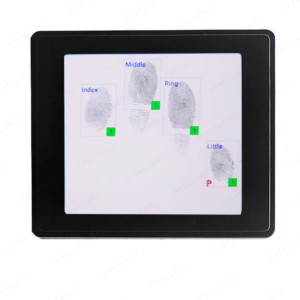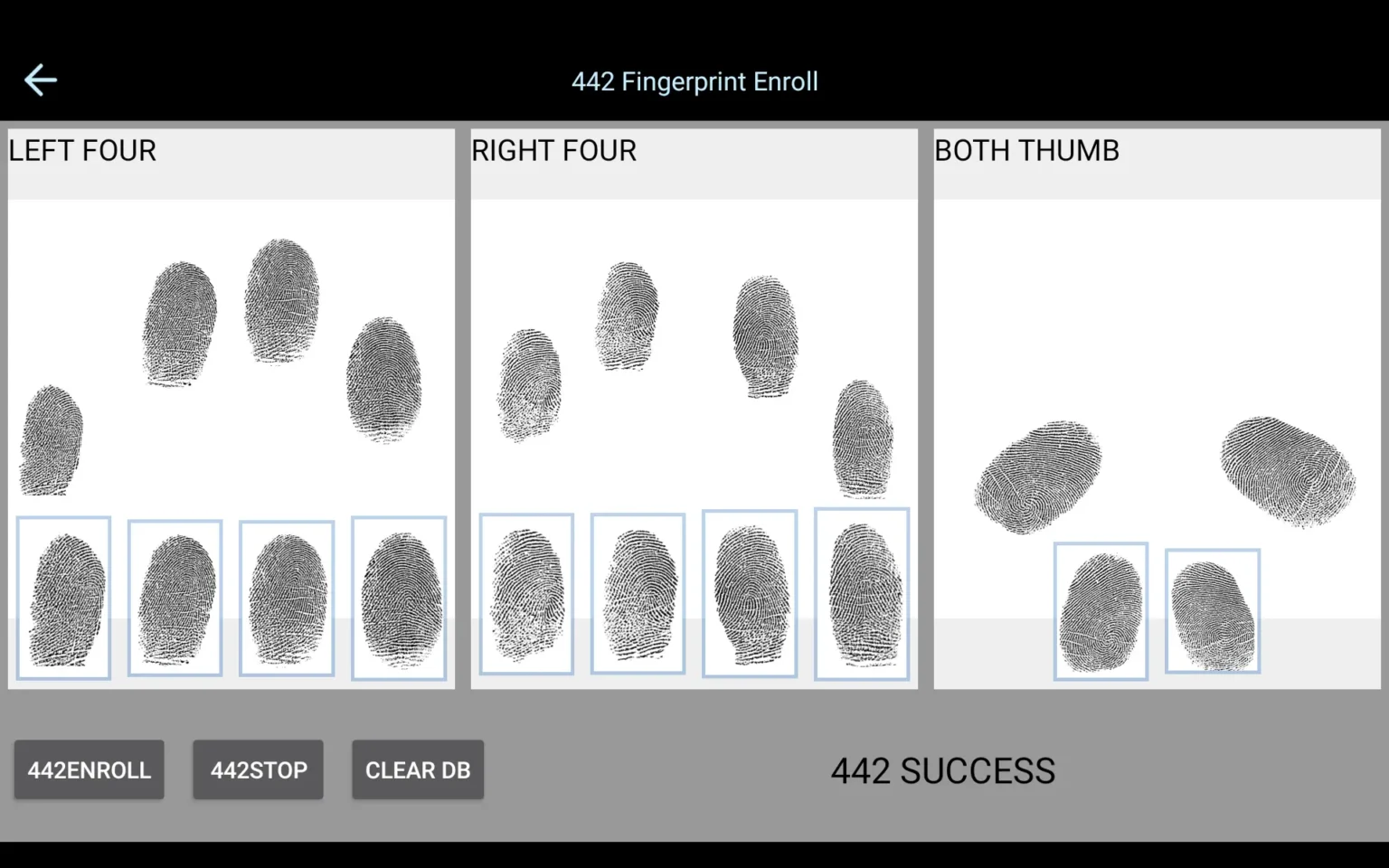How Fingerprint Identification and Verification Work
1.Fingerprint Capture
Сканеры отпечатков пальцев use three primary sensing technologies:
Capacitive Sensors
Сканер отпечатков пальцев technology detects electrical charges from fingerprint ridges using microarrays of semiconductor cells, commonly found in smartphones. This method enables high-resolution fingerprint scanning with enhanced accuracy, speed, and security, ensuring reliable biometric authentication for mobile devices and secure access systems.
Optical Sensors
Сканер отпечатков пальцев technology captures high-resolution fingerprint images using LEDs and photodetectors, a method widely used in law enforcement for forensic analysis and identity verification. This ensures precise, detailed imaging, enabling accurate biometric authentication for security, criminal investigations, and access control systems.
Ultrasonic Sensors
Emit ultrasonic sound waves to map the 3D ridge-valley structures of a fingerprint, enabling highly secure and accurate biometric authentication. This technology, used in Qualcomm’s in-display scanners, works through glass and wet fingers, enhancing smartphone security and access control reliability.
Извлечение признаков
Advanced algorithms convert raw data into minutiae points – unique markers like ridge endings, bifurcations, and islands. Modern systems analyze 50–100 minutiae points per print, creating a digital template encrypted via AES-256 standards.
2.Matching and Verification
Проверка
Сканер отпечатков пальцев technology compares a live fingerprint scan against a pre-registered template to verify identity, commonly used for unlocking smartphones and secure systems. This biometric authentication ensures fast, reliable, and secure access, preventing unauthorized use while enhancing user convenience and data protection.
N Identification
Search a database for fingerprint matches, a technique widely used in criminal investigations and law enforcement. This biometric identification method enables rapid comparison against large datasets, helping to identify suspects, verify identities, and enhance security in forensic and governmental applications.
Liveness Detection
Infrared or pulse oximetry technology detects blood flow and tissue properties to prevent spoofing with artificial fingerprints. This advanced liveness detection ensures high-security biometric authentication, blocking fake prints made from silicone, gel, or other materials used in fraud attempts.
Applications of Fingerprint Biometric Scanners
1.Enterprise and Government
Physical Access Control
Secure entry to offices, data centers, and laboratories using advanced сканер отпечатков пальцев technology, along with facial or palm vein recognition. These high-security solutions ensure only authorized personnel gain access, preventing unauthorized entry and protecting sensitive data and assets.
Time-Attendance Systems
Replace traditional punch cards with tamper-proof biometric logs for accurate and secure attendance tracking. Using fingerprint, facial, or palm vein recognition, this system prevents fraud, eliminates buddy punching, and ensures reliable workforce management in offices, factories, and secure facilities.
Border Security
Integrated into e-passport gates, such as U.S. Global Entry, biometric authentication streamlines border control by using распознавание отпечатков пальцев или лиц for fast, secure, and automated identity verification, reducing wait times while enhancing security at international airports and immigration checkpoints.
2.Consumer Electronics
Smartphones
According to Counterpoint Research (2023), 89% of flagship smartphones now feature сканеры отпечатков пальцев, highlighting their role in secure authentication. This widespread adoption enhances device security, payment verification, and user convenience, making biometric technology a standard in modern mobile devices.
Payment Systems
Biometric POS terminals, such as those used in Mastercard’s Biometric Checkout Program, offer secure, contactless payment authentication. By utilizing распознавание отпечатков пальцев или лиц, these terminals enhance transaction security, reduce fraud, and provide a seamless checkout experience, improving convenience and safety for customers and merchants alike.
3.Healthcare
Идентификация пациента
Fingerprint recognition technology, with 97% accuracy as reported by the NIH, effectively eliminates misidentification errors in hospitals. By accurately verifying patient identities, it ensures correct treatment, reduces medical errors, and enhances overall patient safety, contributing to more efficient and reliable healthcare operations.
Prescription Access
Fingerprint recognition ensures secure controlled medication dispensing by accurately verifying the identity of healthcare professionals. This biometric solution prevents unauthorized access, reduces human errors, and ensures that only authorized personnel can dispense medications, enhancing both patient safety and operational efficiency in healthcare settings.
4.Financial Services
ATM Authentication
Replace traditional PINs with fingerprint verification in high-fraud regions to enhance security. Biometric authentication provides a unique, unforgeable identity check, significantly reducing the risk of identity theft, unauthorized access, and fraudulent transactions, making it a more secure and reliable alternative to PIN-based systems.
Banking Apps
Ensure secure mobile transactions with biometric authentication, such as Bank of America’s biometric login. By using распознавание отпечатков пальцев или лиц, users can securely access their accounts, approve transactions, and protect sensitive financial information, providing a seamless and fraud-resistant experience on mobile banking platforms.
Future Trends and Challenges
1.Advancements
AI-Powered Matching
Neural networks, as demonstrated by NIST benchmarks, reduce false acceptance rates (FAR) to <0.001%, significantly improving the accuracy and reliability of biometric authentication systems for secure identification.
Multi-Modal Systems
Combining fingerprint recognition with vein patterns or behavioral biometrics enhances security by adding multiple layers of authentication, reducing the risk of spoofing and ensuring more reliable identity verification.
Wearable Integration
Smartwatches and rings with embedded biometric scanners, like the Samsung Galaxy Ring, offer convenient, secure authentication. These wearable devices provide сканирование отпечатков пальцев for seamless access control, mobile payments, and enhanced personal security on-the-go.
2. Challenges
Проблемы конфиденциальности
Biometric data breaches pose significant security risks, but on-device template storage mitigates this threat by ensuring biometric templates are stored locally, reducing exposure to external attacks and enhancing user privacy.
Environmental Limitations:
Biometric systems can experience performance degradation in extreme temperatures or wet conditions, affecting accuracy and reliability in such environments.
Ethical Debates
Workplace surveillance and biometric data ownership laws address concerns about privacy and data protection, ensuring proper handling and consent for biometric information.
Часто задаваемые вопросы
Modern scanners with liveness detection (e.g., capacitive pulse sensing) can reject 99.9% of artificial prints made from silicone or gelatin.
Severe burns or scars may reduce accuracy, but advanced systems use adaptive algorithms to update templates over time.
Biometric data is stored as encrypted mathematical templates, not raw images, and often resides in secure hardware modules (e.g., Apple’s Secure Enclave).
Banking, healthcare, and law enforcement leverage its balance of speed and security.
Yes – India’s Aadhaar program uses fingerprint biometrics to manage 1.4 billion identities.
Industrial-grade scanners withstand 10+ years of 24/7 operation with IP65-68 ratings.
Заключение
Fingerprint biometric scanners remain a cornerstone of secure authentication, blending decades of refinement with cutting-edge innovation. From unlocking smartphones to safeguarding national ID programs, this technology’s versatility and reliability make it indispensable in an increasingly digital world. As AI and material science advance, fingerprint systems will evolve to address emerging threats while expanding into new frontiers like wearable tech and decentralized identity management. Organizations adopting these solutions today position themselves at the forefront of a safer, more efficient tomorrow.



